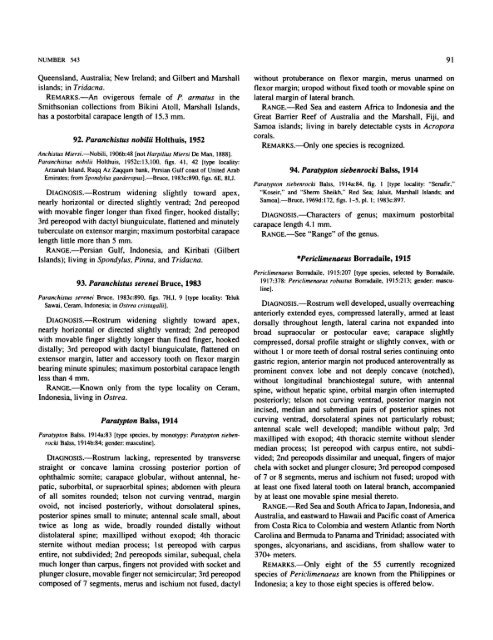SMITHSONIAN CONTRIBUTIONS TO ZOOLOGY • NUMBER 543 ...
SMITHSONIAN CONTRIBUTIONS TO ZOOLOGY • NUMBER 543 ...
SMITHSONIAN CONTRIBUTIONS TO ZOOLOGY • NUMBER 543 ...
You also want an ePaper? Increase the reach of your titles
YUMPU automatically turns print PDFs into web optimized ePapers that Google loves.
<strong>NUMBER</strong> <strong>543</strong> 91<br />
Queensland, Australia; New Ireland; and Gilbert and Marshall<br />
islands; in Tridacna.<br />
REMARKS.—An ovigerous female of P. armatus in the<br />
Smithsonian collections from Bikini Atoll, Marshall Islands,<br />
has a postorbital carapace length of 15.3 mm.<br />
92. Paranchistus nobilii Holthuis, 1952<br />
Anchistus Miersi.—Nobili, 1906b:48 [not Harpilius Miersi De Man, 1888].<br />
Paranchistus nobilii Holthuis, 1952c: 13,100, figs. 41, 42 [type locality:<br />
Arzanah Island, Ruqq Az Zaqqum bank, Persian Gulf coast of United Arab<br />
Emirates; from Spondylus gaederopus].—Bruce, 1983c:89O, figs. 6E, 8I.J.<br />
DIAGNOSIS.—Rostrum widening slightly toward apex,<br />
nearly horizontal or directed slightly ventrad; 2nd pereopod<br />
with movable finger longer than fixed finger, hooked distally;<br />
3rd pereopod with dactyl biunguiculate, flattened and minutely<br />
tuberculate on extensor margin; maximum postorbital carapace<br />
length little more than 5 mm.<br />
RANGE.—Persian Gulf, Indonesia, and Kiribati (Gilbert<br />
Islands); living in Spondylus, Pinna, and Tridacna.<br />
93. Paranchistus serenei Bruce, 1983<br />
Paranchistus serenei Bruce, 1983c:890, figs. 7H.I, 9 [type locality: Teluk<br />
Sawai, Ceram, Indonesia; in Ostrea cristagalli].<br />
DIAGNOSIS.—Rostrum widening slightly toward apex,<br />
nearly horizontal or directed slightly ventrad; 2nd pereopod<br />
with movable finger slightly longer than fixed finger, hooked<br />
distally; 3rd pereopod with dactyl biunguiculate, flattened on<br />
extensor margin, latter and accessory tooth on flexor margin<br />
bearing minute spinules; maximum postorbital carapace length<br />
less than 4 mm.<br />
RANGE.—Known only from the type locality on Ceram,<br />
Indonesia, living in Ostrea.<br />
Paratypton Balss, 1914<br />
Paratypton Balss, 1914a:83 [type species, by monotypy: Paratypton siebenrocki<br />
Balss, 1914b:84; gender: masculine].<br />
DIAGNOSIS.—Rostrum lacking, represented by transverse<br />
straight or concave lamina crossing posterior portion of<br />
ophthalmic somite; carapace globular, without antennal, hepatic,<br />
suborbital, or supraorbital spines; abdomen with pleura<br />
of all somites rounded; telson not curving ventrad, margin<br />
ovoid, not incised posteriorly, without dorsolateral spines,<br />
posterior spines small to minute; antennal scale small, about<br />
twice as long as wide, broadly rounded distally without<br />
distolateral spine; maxilliped without exopod; 4th thoracic<br />
sternite without median process; 1st pereopod with carpus<br />
entire, not subdivided; 2nd pereopods similar, subequal, chela<br />
much longer than carpus, fingers not provided with socket and<br />
plunger closure, movable finger not semicircular; 3rd pereopod<br />
composed of 7 segments, merus and ischium not fused, dactyl<br />
without protuberance on flexor margin, merus unarmed on<br />
flexor margin; uropod without fixed tooth or movable spine on<br />
lateral margin of lateral branch.<br />
RANGE.—Red Sea and eastern Africa to Indonesia and the<br />
Great Barrier Reef of Australia and the Marshall, Fiji, and<br />
Samoa islands; living in barely detectable cysts in Acropora<br />
corals.<br />
REMARKS.—Only one species is recognized.<br />
94. Paratypton siebenrocki Balss, 1914<br />
Paratypton siebenrocki Balss, 1914a:84, fig. 1 [type locality: "Senafir,"<br />
"Koseir," and "Sherm Sheikh," Red Sea; Jaluit, Marshall Islands; and<br />
Samoa].—Bruce, 1969d:172, figs, l-5.pl. 1; 1983c:897.<br />
DIAGNOSIS.—Characters of genus; maximum postorbital<br />
carapace length 4.1 mm.<br />
RANGE.—See "Range" of the genus.<br />
*Periclimenaeus Borradaile, 1915<br />
Periclimenaeus Borradaile, 1915:207 [type species, selected by Borradaile,<br />
1917:378: Periclimenaeus robustus Borradaile, 1915:213; gender: masculine].<br />
DIAGNOSIS.—Rostrum well developed, usually overreaching<br />
anteriorly extended eyes, compressed laterally, armed at least<br />
dorsally throughout length, lateral carina not expanded into<br />
broad supraocular or postocular eave; carapace slightly<br />
compressed, dorsal profile straight or slightly convex, with or<br />
without 1 or more teeth of dorsal rostral series continuing onto<br />
gastric region, anterior margin not produced anteroventrally as<br />
prominent convex lobe and not deeply concave (notched),<br />
without longitudinal branchiostegal suture, with antennal<br />
spine, without hepatic spine, orbital margin often interrupted<br />
posteriorly; telson not curving ventrad, posterior margin not<br />
incised, median and submedian pairs of posterior spines not<br />
curving ventrad, dorsolateral spines not particularly robust;<br />
antennal scale well developed; mandible without palp; 3rd<br />
maxilliped with exopod; 4th thoracic sternite without slender<br />
median process; 1st pereopod with carpus entire, not subdivided;<br />
2nd pereopods dissimilar and unequal, fingers of major<br />
chela with socket and plunger closure; 3rd pereopod composed<br />
of 7 or 8 segments, merus and ischium not fused; uropod with<br />
at least one fixed lateral tooth on lateral branch, accompanied<br />
by at least one movable spine mesial thereto.<br />
RANGE.—Red Sea and South Africa to Japan, Indonesia, and<br />
Australia, and eastward to Hawaii and Pacific coast of America<br />
from Costa Rica to Colombia and western Atlantic from North<br />
Carolina and Bermuda to Panama and Trinidad; associated with<br />
sponges, alcyonarians, and ascidians, from shallow water to<br />
37Of meters.<br />
REMARKS.—Only eight of the 55 currently recognized<br />
species of Periclimenaeus are known from the Philippines or<br />
Indonesia; a key to those eight species is offered below.

















